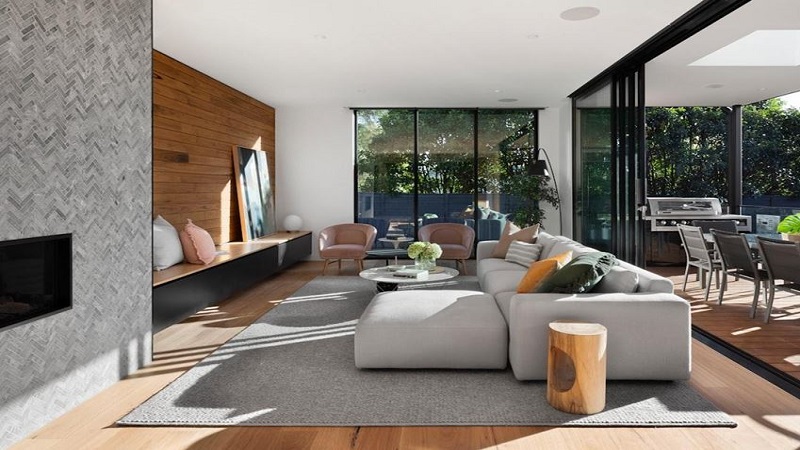- Smart home technology: Incorporate smart thermostats, automated lighting, and integrated security systems for convenience, security, and energy efficiency.
- Energy-efficient design: Use solar panels, energy-efficient windows, and smart insulation to reduce costs and environmental impact.
- Sustainable materials: Choose reclaimed wood, bamboo, and recycled metal for eco-friendliness and unique aesthetic appeal.
- Multi-functional spaces: Design adaptable rooms with multi-purpose uses, like home office/guest room combos and modular furniture.
- Indoor-outdoor integration: Use retractable glass walls, outdoor kitchens, and seamless flooring to blend indoor and outdoor spaces.
- Health and wellness features: Include home gyms, spa-like bathrooms, and air purification systems for enhanced well-being.
- Advanced kitchen design: Implement smart appliances, large kitchen islands, and walk-in pantries for improved functionality and enjoyment.

Building a custom home is an exciting opportunity to create a living space tailored to your unique needs and preferences. One of the main advantages of custom homes is the ability to incorporate innovative features that enhance functionality, comfort, and aesthetic appeal. As you embark on the journey of designing your dream home, it’s essential to consider various innovative features that can make your home truly special. In this blog, we’ll explore a range of innovative features to include in your custom home, ensuring it meets your current needs and future aspirations.
Smart Home Technology
Smart home technology has become increasingly popular, offering unparalleled convenience, security, and energy efficiency. Integrating smart technology into your custom home can significantly enhance your daily living experience.
Key smart home features to consider include smart thermostats, automated lighting, and integrated security systems. Smart thermostats learn your schedule and preferences, adjusting the temperature to optimize comfort and energy savings. Automated lighting systems allow you to control lights remotely or set schedules, providing both convenience and energy efficiency. Integrated security systems, including cameras, motion sensors, and smart locks, offer enhanced protection and peace of mind.
The benefits of smart home technology extend beyond convenience. These systems can help reduce energy consumption, lower utility bills, and provide a safer living environment. By incorporating smart home features, you create a modern, efficient, and secure home that adapts to your lifestyle.
Energy-Efficient Design
Energy efficiency is a crucial consideration in modern home design. Implementing innovative energy-efficient features in your custom home can lead to significant cost savings and reduce your environmental impact.
Solar panels are a popular energy-efficient feature, harnessing the power of the sun to generate electricity for your home. Energy-efficient windows, with advanced glazing and insulation properties, help maintain a comfortable indoor temperature and reduce heating and cooling costs. Smart insulation materials, such as spray foam or insulated concrete forms, provide superior thermal performance, further enhancing energy efficiency.
The long-term benefits of energy-efficient design include lower utility bills, increased home value, and a reduced carbon footprint. By prioritizing energy efficiency, you create a sustainable home that benefits both your wallet and the environment.
Sustainable Materials
The use of sustainable materials in home construction is a growing trend, driven by increasing awareness of environmental issues and a desire for unique, eco-friendly homes. Incorporating sustainable materials into your custom home can add character and reduce your environmental impact.
Examples of sustainable materials include reclaimed wood, bamboo, and recycled metal. Reclaimed wood offers a rustic, weathered look that adds warmth and texture to interiors. Bamboo is a versatile, rapidly renewable resource ideal for flooring and cabinetry. Recycled metal can be used for roofing, fixtures, and structural elements, providing durability and a modern aesthetic.
Using sustainable materials not only contributes to environmental conservation but also creates a unique, personalized home. These materials often have distinctive textures and appearances that add charm and individuality to your living spaces.
Multi-Functional Spaces
Designing multi-functional spaces is essential for creating a versatile and adaptable home. These spaces can serve multiple purposes, allowing you to make the most of your home’s square footage and adapt to changing needs over time.
Ideas for multi-functional rooms include home office/guest room combinations, adaptable living areas, and modular furniture. A home office can double as a guest room with the addition of a Murphy bed or sofa bed. Adaptable living areas can be reconfigured for different activities, such as family gatherings, exercise, or relaxation. Modular furniture, like sectional sofas and adjustable shelving units, provides flexibility and can be easily rearranged to suit various purposes.
By incorporating multi-functional spaces, you create a home that is not only practical and efficient but also capable of evolving with your lifestyle. This flexibility ensures your home remains relevant and functional for years to come.
Indoor-Outdoor Integration
Blending indoor and outdoor living spaces is a trend that enhances the overall living experience by creating a seamless connection with nature. Innovative features that facilitate indoor-outdoor integration can expand your living space and provide a sense of openness and freedom.
Retractable glass walls are a striking feature that allows you to open up your living areas to the outdoors, creating a fluid transition between indoor and outdoor spaces. Outdoor kitchens equipped with cooking and dining facilities extend your entertaining space and make alfresco dining a pleasure. Seamless flooring transitions, such as using the same or similar materials indoors and outdoors, further enhance the connection between these areas.
Integrating indoor and outdoor spaces provides numerous benefits, including increased natural light, improved ventilation, and enhanced opportunities for relaxation and entertainment. By embracing this trend, you create a home that celebrates the beauty of its surroundings and encourages a healthy, balanced lifestyle.
Health and Wellness Features
Incorporating health and wellness features into your home design can significantly enhance your quality of life. These features promote physical and mental well-being, creating a living environment that supports a healthy lifestyle.
Innovative health and wellness features to consider include home gyms, spa-like bathrooms, and air purification systems. A home gym equipped with exercise equipment and ample space for workouts encourages regular physical activity. Spa-like bathrooms with features such as steam showers, soaking tubs, and heated floors provide a relaxing retreat where you can unwind and rejuvenate. Air purification systems improve indoor air quality by removing pollutants, allergens, and toxins, ensuring a healthier living environment.
By prioritizing health and wellness in your home design, you create a space that nurtures your well-being and enhances your daily living experience. These features contribute to a balanced, fulfilling lifestyle and promote long-term health.
Advanced Kitchen Design
The kitchen is often considered the heart of the home, making its design a critical aspect of any custom home project. Incorporating advanced kitchen features can enhance the functionality, efficiency, and enjoyment of this vital space.
Innovative kitchen features to consider include smart appliances, large kitchen islands, and walk-in pantries. Smart appliances, such as refrigerators, ovens, and dishwashers, offer advanced capabilities, including remote operation, energy-saving modes, and personalized settings. Large kitchen islands provide additional workspace, storage, and seating, making them a versatile and practical addition to any kitchen. Walk-in pantries offer ample storage space for groceries, kitchen equipment, and bulk items, helping to keep your kitchen organized and clutter-free.
A well-designed kitchen not only enhances the overall functionality of your home but also makes cooking and entertaining more enjoyable. By incorporating advanced kitchen features, you create a space that is both practical and inviting.
Conclusion
Incorporating innovative features into your custom home design ensures that your living space is both functional and future-ready. From smart home technology and energy-efficient design to sustainable materials, multi-functional spaces, indoor-outdoor integration, health and wellness features, and advanced kitchen design, these elements can significantly enhance your home’s comfort, convenience, and aesthetic appeal. As you plan your custom home, consider working with custom home design experts to seamlessly integrate these innovative features, creating a home that meets your needs and reflects your vision.
